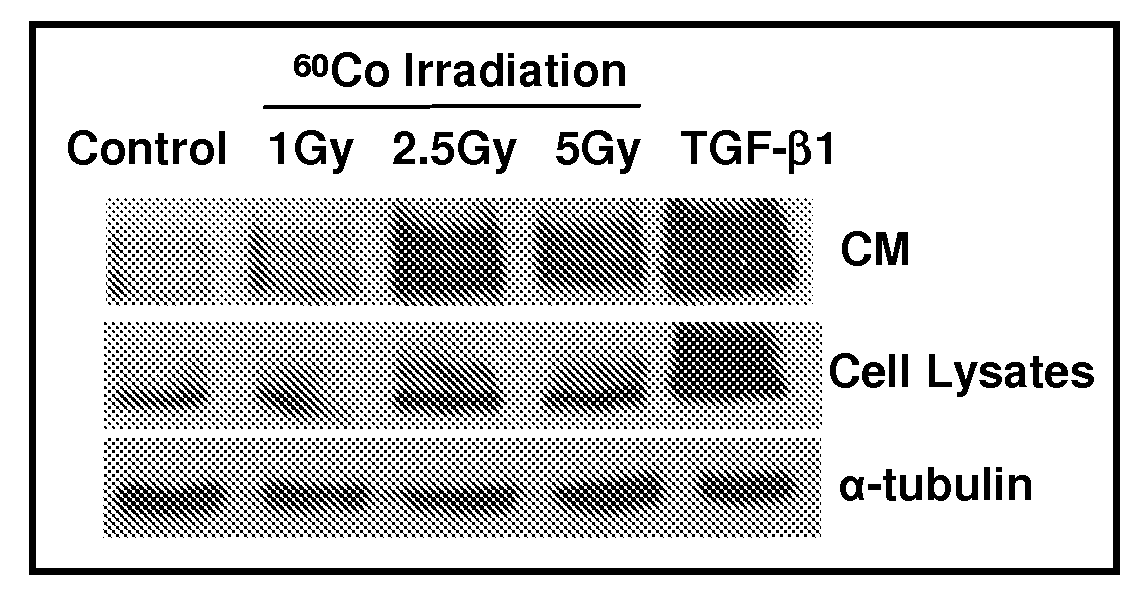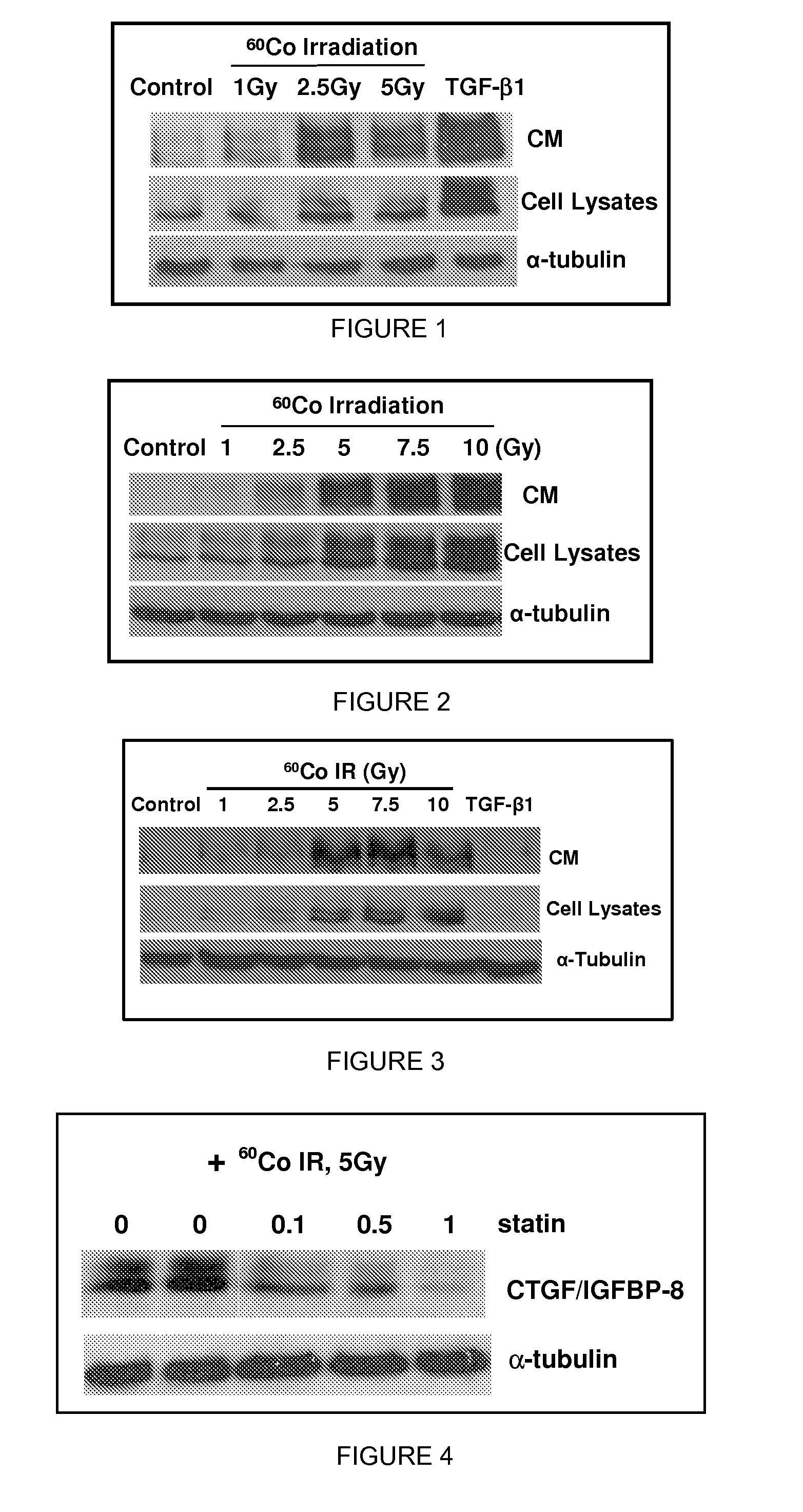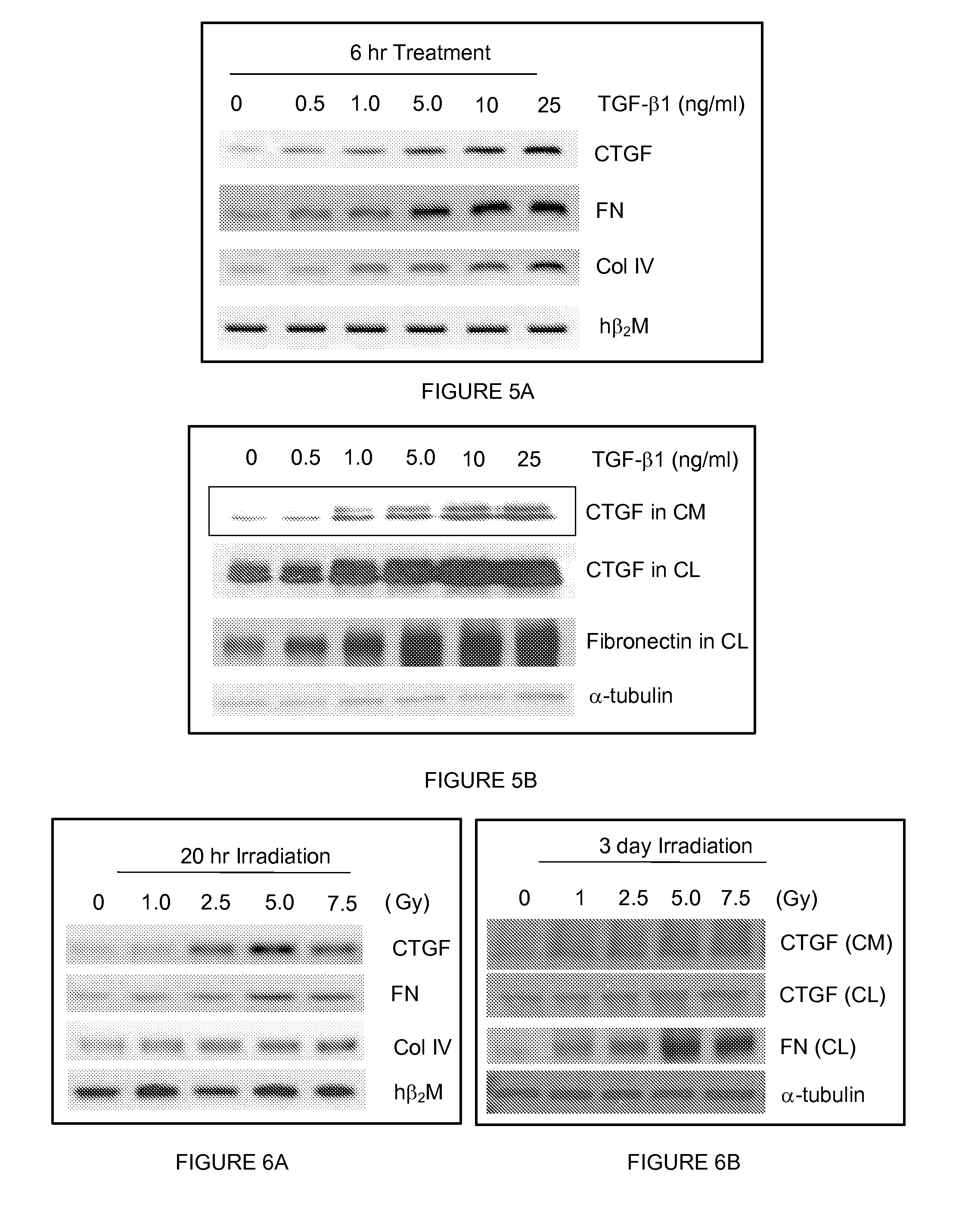Methods and compositions for treatment or prevention of radiation-induced fibrosis
a radiation-induced fibrosis and composition technology, applied in the field of methods and compositions for treating or preventing radiation-induced fibrosis, can solve the problems of dysfunctional repair and rif, radiation therapy treatment creates a dilemma, significant deterioration in the quality of life, etc., and achieves the effect of preventing rif, inhibiting ctgf expression, and treating or preventing ri
- Summary
- Abstract
- Description
- Claims
- Application Information
AI Technical Summary
Benefits of technology
Problems solved by technology
Method used
Image
Examples
example 1
Materials and Methods
[0080]Cell Culture and Treatment. Normal human fetal lung fibroblasts (HFL-1) were purchased from the American Type Culture Collection (ATCC Number: CCL-153) and cultured in Ham's F12K medium (American Type Culture Collection) supplemented with 2 mM L-glutamine adjusted to contain 1.5 g / L sodium bicarbonate and 10% fetal bovine serum. Cells were maintained in humidified 5% CO2 at 37° C. Human dermal fibroblasts (HDF), derived from the dermis of normal human adult skin, were purchased from Invitrogen, Inc. and cultured in Medium-106 (Invitrogen, Inc., Catalogue No. M-106-500) containing LSGS Kit (Invitrogen, Inc., Catalogue No. S-003-K) prior to use. After reaching 75-80% confluence, the medium was changed to serum free medium (SFM) for irradiation with different dose 1Gy, 2.5Gy, 5Gy, 7.5Gy and 10 Gy by using 137Se. Alternatively, cells were treated with 5 ng / ml TGF-β1 (Sigma-Aldrich, Inc., Catalogue No. T7039) to stimulate CTGF production. The cells were then ke...
example 2
Induction of CTGF, Fibronectin, and Collagen Type IV with TGF-β1
[0085]Normal human fetal lung fibroblasts (HFL-1) were treated with varying concentrations of TGF-β1, ranging from 0 ng / ml to 25 ng / ml. In order to detect expression of CTGF and fibrotic proteins mRNAs, RNA was extracted from HFL-1 cells treated with TGF-β1, and RT-PCR was performed to specifically detect expression of CTGF, fibronectin (FN), collagen type IV (Col IV), and hβ2M mRNA. FIG. 5A is an agarose gel of RT-PCR products detected in HFL-1 cells following a six (6) hour treatment with TGF-β1. As shown in FIG. 5A, expression of CTGF, FN, and Col IV mRNA increased as the concentration of TGF-β1 increased. hβ2M mRNA was used as an internal control for the RT-PCR process.
[0086]Protein expression in HFL-1 cells treated with TGF-β1 was also determined. Three days following treatment with the indicated amount of TGF-β1, HFL-1 cells were harvested, and cell lysates were separated by SDS-PAGE. The separated proteins were t...
example 3
Induction of CTGF, Fibronectin, and Collagen Type IV with Radiation
[0087]In an effort to determine the mechanism of radiation-induced fibrosis, HFL-1 cells were exposed to increasing amounts of radiation, ranging from 0 to 7.5 Grays (Gy). To detect mRNA expression of CTGF and fibrotic proteins mRNAs, RNA was extracted from irradiated HFL-1 cells, and RT-PCR was performed to specifically detect expression of CTGF, fibronectin (FN), collagen type IV (Col IV), and hβ2M mRNA. FIG. 6A is an agarose gel of an RT-PCR analysis of mRNA expression in HFL-1 cells collected 20 hours following exposure to radiation. As shown in FIG. 6A, the expression of CTGF and fibrotic protein mRNA increased as the amount of radiation increased.
[0088]Protein expression in HFL-1 cells exposed to radiation was also determined. Three days following exposure to radiation, HFL-1 cells were harvested, and cell lysates were separated by SDS-PAGE. The separated proteins were then transferred to nitrocellulose, and We...
PUM
 Login to View More
Login to View More Abstract
Description
Claims
Application Information
 Login to View More
Login to View More - R&D
- Intellectual Property
- Life Sciences
- Materials
- Tech Scout
- Unparalleled Data Quality
- Higher Quality Content
- 60% Fewer Hallucinations
Browse by: Latest US Patents, China's latest patents, Technical Efficacy Thesaurus, Application Domain, Technology Topic, Popular Technical Reports.
© 2025 PatSnap. All rights reserved.Legal|Privacy policy|Modern Slavery Act Transparency Statement|Sitemap|About US| Contact US: help@patsnap.com



